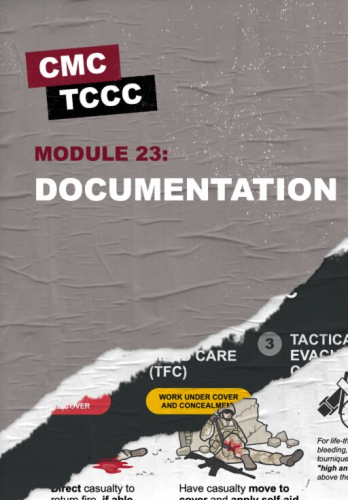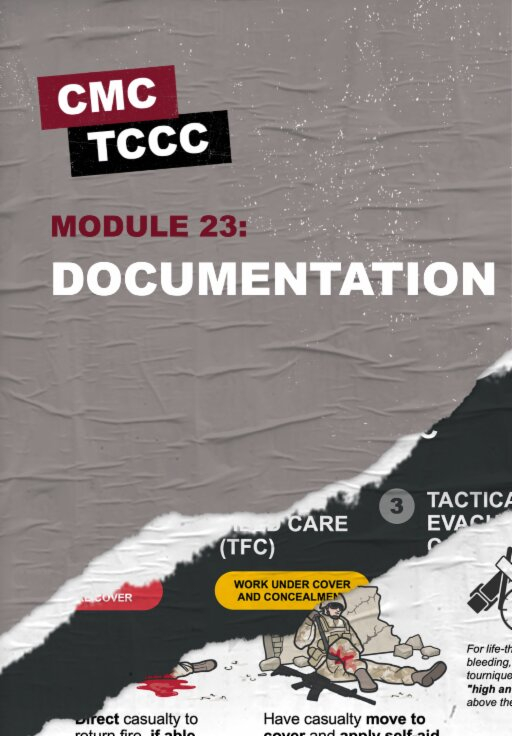Support the development of the TCCC project in Ukraine
Module 23: Documentation
This module discusses the importance of and techniques for documentation of both casualty assessment and the treatment provided by the Combat Medic/Corpsman in the Tactical Field Care (TFC) phase of Tactical Combat Casualty Care (TCCC).
Documentation

In Module 23, we will discuss the importance of and techniques for documentation of both casualty assessment and the treatment provided by the Combat Medic/Corpsman in the Tactical Field Care (TFC) phase of Tactical Combat Casualty Care (TCCC).
Tactical Combat Casualty Care is broken up into four roles of care. As a Combat Medic/Corpsman, you are the first medical provider to care for the casualty and initiate more advanced treatments in the continuum of prehospital care. It is important that you understand the roles and responsibilities of the nonmedical personnel (All Service Members and Combat Lifesavers) who may be assessing, providing care/assisting in the treatment of casualties in the prehospital environment. They may be involved in the documentation of care as well.

There are 2 cognitive and 2 performance learning objectives for the Documentation module.
The cognitive learning objectives are: identify how to document casualty information on the DD Form 1380 TCCC Card and the proper placement of that card on the casualty and identify the importance and information considerations of a casualty After Action Report submission.
The performance learning objectives are to demonstrate the proper documentation of care on a trauma casualty in Tactical Field Care and demonstrate the completion of an After Action Report.
Documentation of care on the battlefield is not just an administrative requirement. It provides crucial information to other providers in the continuum of care that informs further assessment and treatment. The casualty’s level of consciousness and vital signs, when a tourniquet was applied, and if and when analgesics or tranexamic acid (TXA) were administered are examples of information that might directly impact ongoing casualty care.
Prehospital documentation becomes part of the casualty’s longitudinal medical record, permanently recording injuries and wounds sustained and the care provided.
Furthermore, the care and outcomes data captured in prehospital documentation becomes part of the Department of Defense (DoD) Trauma Registry, informs evidence-based combat casualty care process improvement, and helps to shape the future of battlefield trauma care.
Despite the importance of recording the prehospital combat casualty care provided, analysis of data from the US Military’s experience in Iraq and Afghanistan over a six-year period from 2001 to 2007 revealed that less than 10 percent of casualties had documentation of the care that was provided before the casualty reached a medical treatment facility.
The numerous challenges in documenting battlefield casualty care are well established. The first responders and Combat Medics/Corpsmen who are responsible for documentation are often task-saturated caring for multiple casualties and preparing casualties for evacuation while continuing to support the unit’s primary mission. They frequently face significant time, environmental, and tactical constraints in the prehospital environment that make real-time documentation of casualty assessment and the care provided difficult at best. Documentation is often an afterthought completed only when time is available, and the situation permits.
It is important to remember that you have not finished caring for a casualty until you have properly documented the care.
In many instances, the first responders providing prehospital care at the point of wounding are not medical providers. Documentation of care by nonmedical personnel requires a format that can be easily understood and used effectively.
All assessment and medical treatments (including interventions and medications) performed should be documented on the casualty’s Tactical Combat Casualty Care Card (DD Form 1380) which can be found in the Joint First Aid Kit (JFAK).
The card was designed by medics based on the principles of TCCC, includes only essential information, and addresses initial lifesaving care. The card is easy to use and can be filled out in less than 2 minutes. Best practice is for units to ensure that each Service member prepopulates the top portion (casualty demographics) of their TCCC Card to facilitate timely and accurate documentation.
Documentation on the TCCC Card should be completed by whoever is providing care at the point of injury or wounding and updated with any changes in the casualty’s status or additional care rendered by all subsequent prehospital providers.
After appropriate documentation has been completed, the TCCC Card (DD Form 1380) should be attached to the casualty in a visible location and handed off during evacuation to the next higher level in the prehospital care continuum. The TCCC Card will become a permanent part of the Service member’s longitudinal medical record.
This video demonstrates the use of the DD Form 1380 (TCCC Card).
Remember that the casualty’s TCCC Card, found in the JFAK, should be used by whoever is providing care at the point of injury to document all assessments and treatments rendered.
DD FORM 1380 (TCCC Card) Video
Due to the constraints of the prehospital environment, care is not always documented, or completely documented, in real-time on the TCCC Card (DD Form 1380). Accordingly, care should be documented and/or supplemented retrospectively by whoever rendered the care utilizing the TCCC After Action Report (AAR).
This electronic AAR is intended to be completed after the first responder or Combat Medic/Corpsman completes the mission and returns to base. It is a more detailed and complete record of the care provided than the TCCC Card. It is completed by or with (in the case of a nonmedical first responder) the unit Combat Medic/Corpsman and submitted electronically via the Joint Trauma System (JTS) website within 72 hours following the mission. Both the TCCC Card and the TCCC AAR are required for optimal documentation of prehospital care.

1 PDF DD Form 1380 (TCCC Card) Skills Card

2 PDF TCCC After Action Report (AAR) Skills Card

To close out this module, check your learning with the questions below (answers under the image).
Check on learning
Answers
Why is it important to document prehospital combat casualty care?
Documentation of care on the battlefield is not just an administrative requirement. It provides crucial information to other providers in the continuum of care that informs further assessment and treatment. The casualty’s level of consciousness and vital signs, when a tourniquet was applied, and if and when analgesics or TXA were administered are examples of information that might directly impact ongoing casualty care.
Prehospital documentation becomes part of the casualty’s longitudinal medical record, permanently recording injuries and wounds sustained and the care provided.
Furthermore, the care and outcomes data captured in prehospital documentation informs evidence-based combat casualty care process improvement and helps to shape the future of battlefield trauma care.
What is the difference between the TCCC Card (DD Form 1380) and the TCCC After Action Report (AAR)?
The TCCC Card (DD Form 1380) is filled out in real-time (when assessments are completed and care is rendered) by whoever is providing the care at point of wounding or injury. The card may be filled out by nonmedical personnel or a Combat Medic/Corpsman. After appropriate documentation has been completed, the TCCC Card (DD Form 1380) should be attached to the casualty in a visible location and handed off during evacuation to the next higher level in the prehospital care continuum. The TCCC Card will become a permanent part of the Service member’s longitudinal medical record.
The TCCC After Action Report is completed retrospectively after the mission is complete and the first responder has returned to base. This electronic AAR is intended to be completed by whoever rendered the care after the first responder or Combat Medic/Corpsman completes the mission. It is a more detailed and complete record of the care provided than the TCCC Card. It is completed by or with (in the case of a nonmedical first responder) the unit Combat Medic/Corpsman and submitted electronically by the Combat Medic/Corpsman via the Joint Trauma System website within 72 hours following the mission.
True or False? Only the Combat Medic/Corpsman can document prehospital care for a casualty using the TCCC Card (DD Form 1380)?
False. Documentation on the TCCC Card (DD Form 1380) should be completed by whoever is providing care at the point of injury or wounding and updated with any changes in the casualty’s status or additional care rendered by all subsequent prehospital providers. Documentation can be completed by nonmedical personnel or the Combat Medic/Corpsman.

You can discuss this material on the TCCC forum



























